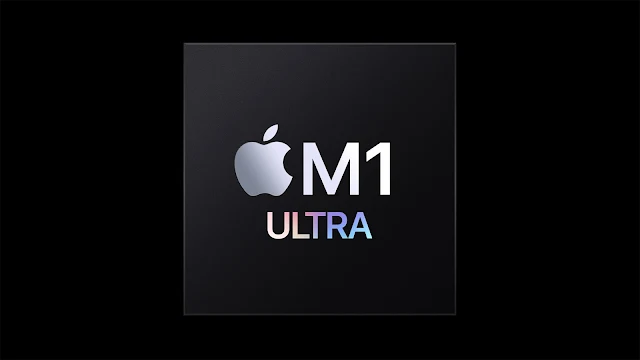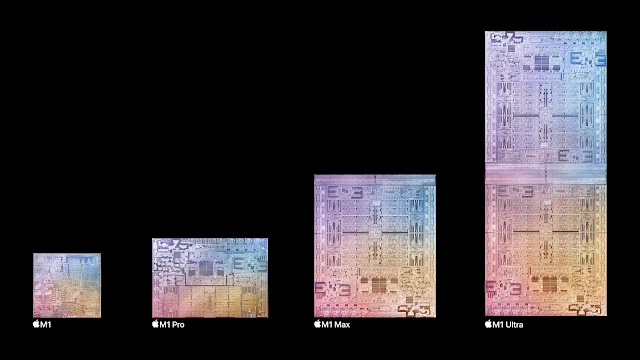At the same event in which Apple announced the iPhone SE 2022 with the A15 Bionic chip, and the updated iPad Air with the M1 chip, the company also revealed its most powerful chipset ever, the M1 Ultra, in addition to the Mac Studio and Studio Display.
The New M1 Ultra Chip:
Apple continues to lead the competition in the scope of processors, whether it comes to smartphones, tablets, or personal computers, and after a few months of revealing the M1 Pro and M1 Max chips as the most powerful and least power-consuming computer processors in the world, Apple announced a new chip that will expand the gap between Apple computers and Windows computers to infinity.
The M1 Ultra chip consists of two M1 Max chips connected by UltraFusion, a technology from Apple that interconnects the die of two M1 Max chips to create a single, power-efficient System on Chip (SoC) with impressive capabilities.
Configurable with up to 128GB of unified memory (RAM), the new M1 Ultra consists of a 20-core CPU, 64-core GPU, and 32-core Neural Engine, delivering superior performance and unlocking the potential for developers, artists, and video professionals, to complete large projects quickly and efficiently. Thanks to its ARM architecture, the M1 Ultra chip also does not consume as much power compared to traditional Intel and AMD processors.
In numbers, and according to Apple, the new M1 Ultra delivers 90 percent higher multi-threaded performance than the fastest available 16-core PC desktop chip in the same power envelope, using 100 fewer watts. Additionally, it's delivering faster GPU performance than even the highest-end PC GPU available while using 200 fewer watts of power. Moreover, the M1 Ultra can also play back up to 18 streams of 8K ProRes 422 videos.
Mac Studio:
Mac Studio is a new Mac from Apple that is somewhat similar in design to the design of the Mac mini, but with a height of 3.7 inches. It's roughly shaped like 3 Mac minis stacked on top of each other.
Despite its small size, Mac Studio comes with the M1 Max or M1 Ultra chip, which makes it a powerful device, suitable for people who are looking for more performance for heavier tasks.
According to Apple, the Mac Studio with M1 Max is 2.5 times faster in the CPU and 7.5 times faster in the GPU than the 27-inch iMac with a 10-core processor. It's also up to 50 percent faster in CPU than a Mac Pro with a 16-core Xeon processor, and 3 times faster in a GPU than a Mac Pro with the most popular graphics card.
With the M1 Ultra, Mac Studio is up to 3.8 times faster in the CPU and delivers up to 4.5x faster graphics performance compared to an iMac equipped with a 10-core processor. Moreover, Mac Studio with M1 Ultra is up to 90% faster in CPU performance than Mac Pro with a 16-core Xeon processor, up to 60% faster in CPU than 28-core Mac Pro, and up to 80% faster than the fastest Mac graphics card available today, according to Apple always.
Mac Studio on the back has 4 Thunderbolt ports, a 10Gb Ethernet port, two USB-A ports, an HDMI port, and a 3.5 mm audio jack. On the front, the device has 3 USB-C ports and an SDXC card slot.
Mac Studio has a built-in Wi-Fi 6 and Bluetooth 5.0 as well, and it can be connected to up to 4 Pro Display XDRs, plus a 4K TV.
Mac Studio with M1 Max is available with up to 10-core CPU, 32-core GPU, and 16-core Neural Engine, with up to 64 GB unified RAM and up to 8 TB SSD storage, starting at 1999 USD.
Mac Studio with M1 Ultra is available with up to 20-core CPU, 64-core GPU, and 32-core Neural Engine, with up to 128 GB unified RAM and up to 8 TB SSD storage, starting at 3999 USD.
Studio Display:
The Studio Display is Apple's new 27-inch 5K external Retina display powered by the A13 Bionic chip, a 12MP ultra-wide camera that supports Center Stage, a six-speaker Hi-Res sound system with spatial audio support, and a three-microphone array with an especially low noise floor for crystal-clear calls and voice recordings.
The device features a 27-inch 5K Retina display with over 14.7 million pixels, 600 nits of brightness, a P3 wide color, with an anti-reflective coating, and supports True Tone technology. Studio Display offers also a nano-texture glass option for workspaces with bright light sources to help minimize light to further reduce glare.
Studio Display has a built-in stand that allows the user to tilt the display up to 30 degrees. Apple also offers the option of a tilt-and-height-adjustable stand with a counterbalancing arm or a VESA mount adapter that supports landscape or portrait orientation.
The Studio Display has three USB-C ports that deliver speeds of up to 10Gb/s for high-speed peripherals, storage, and networking, and a Thunderbolt port that is capable of outputting 96W of power using the in-box thunderbolt cable, allowing the Studio Display to charge MacBook devices quickly. Additionally, up to three Studio Displays can be connected to a MacBook Pro, creating a powerful editing space or animation workspace.
Studio Display is available for ordering from now, starting at 1599 USD.










